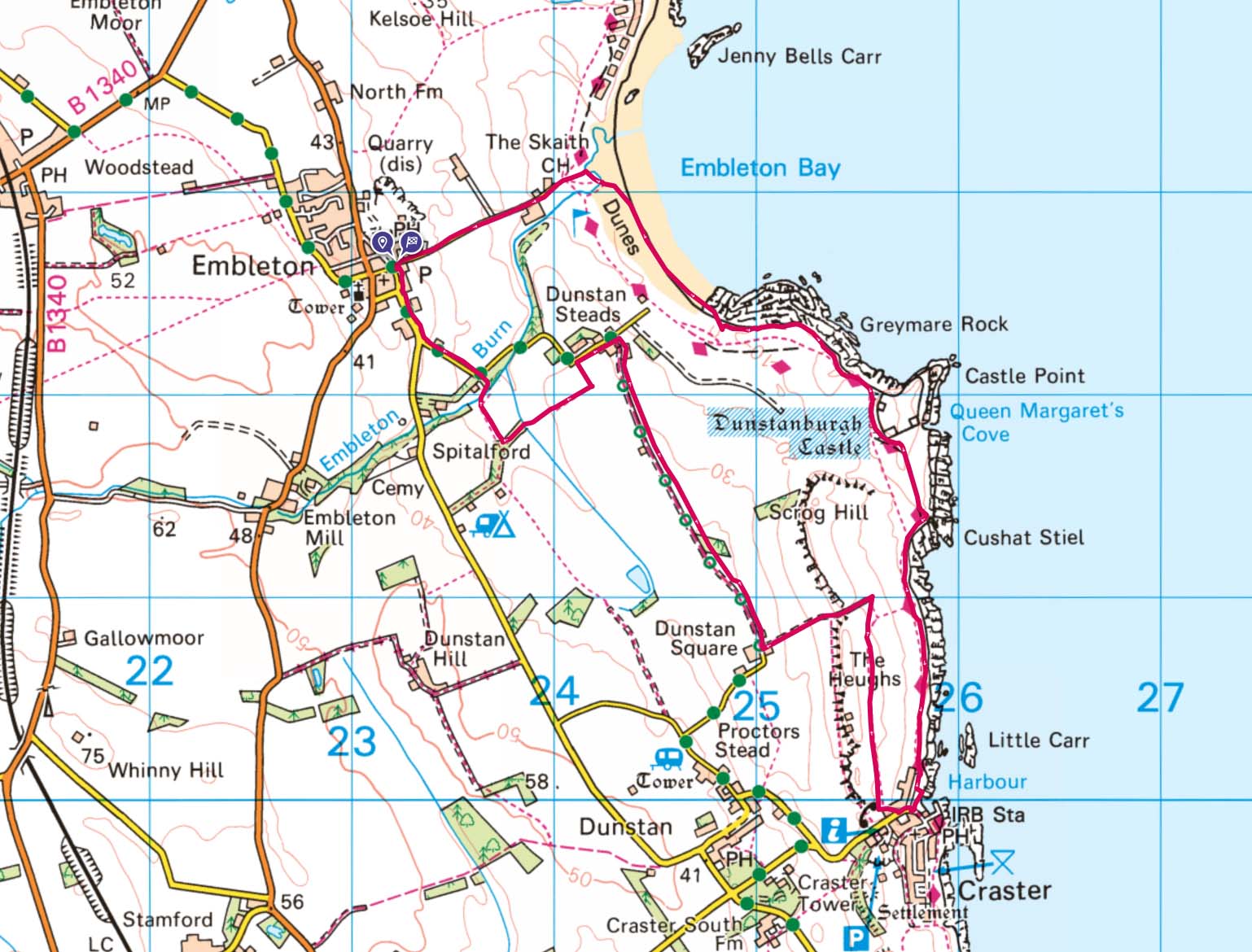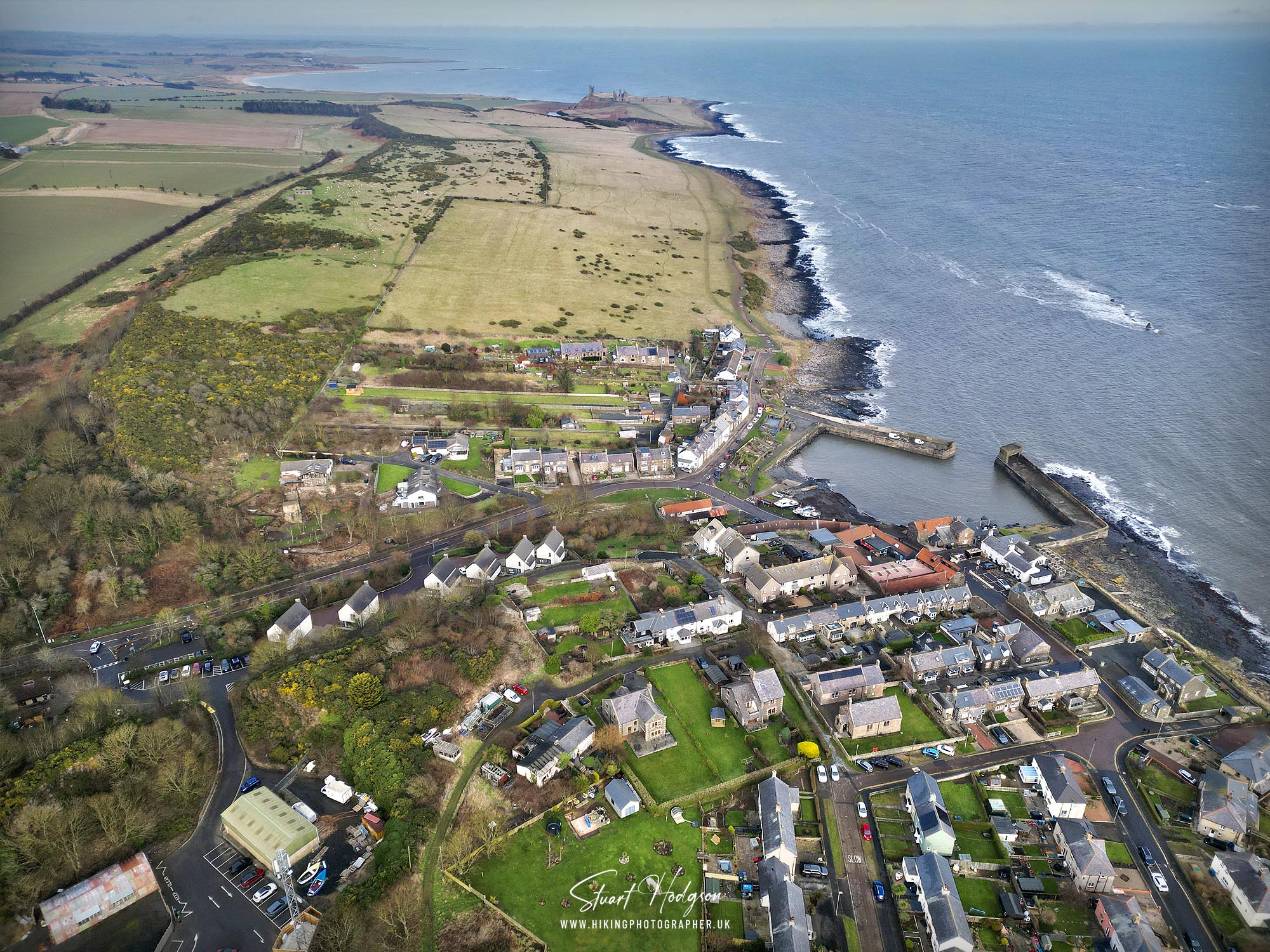Dunstanburgh Castle – One of BRITAINS best coastal walks in Northumberland
Dunstanburgh Castle, perched dramatically on the rugged Northumberland coast in North Eastern England, is a striking and distinctive medieval ruin with a rich history and makes for an excellent coastal walk, which can be reached from either Craster or Embleton.
You can’t park the car next to Dunstanburgh Castle – you do have to walk to it, and the closest places are either Craster to the south or Embleton to the north – and both are around 1.5 miles away.
My prefered route largely depends on the weather and time of day. If it’s during the day and the tide is out – I prefer to walk to the castle from Embleton, and onto the stunning and prstine Embleton Bay beach where you can see Dunstanburgh Castle’s imposing silhouette long before you reach its entrance. You can also walk to Dunstanburgh Castle from Craster, which is another nice route on grass, especially on a summers evening when the sun is setting behind the castle. Whatever route you choose – make sure when in this part of the world, that you see Embleton Bay & Craster!

Embleton Bay taken from my drone, with Dunstanburgh Castle in the distance. I love this beach – it’s one of my all time favourites! A walk to Dunstanburgh Castle which includes Embleton Bay was voted in the top 10 of Britain favourite walks in a recent TV series, so I really do recommend visiting Embleton Bay when in this area.
DUNSTANBURGH CASTLE – 3 BEST WALKING ROUTES
You have a number of walking options to see Dunstanburgh Castle really. The simpler and quickest/shotest routes are to walk to Dunstaburgh Castle and back along the well trodden coastal paths from either Embleton in the north or Craster to the south, and simply retrace your steps once you arrive at Dunstanburgh Castle. Both of these routes are around 3 miles in total on flattish ground, and ideal if you are pushed for time or have kids with you. If I had to pick one – I’d go from Embleton for that beach – and below I have featured this short route from Embleton, so you get to see Embleton Bay
I have also featured below two longer routes if you have more time. A circular route, which again starts from Embelton (but can be adapted to start from Craster) – which takes in the full coastal path, and an inland path. It ensures a visit to Craster, Embleton, Embleton Bay as well of Dunstanburgh Castle – so ticks all the boxes The other longer route featured is a long linear route from Craster, to Low Newton-by-the-sea, via Dunstanburgh Castle – and then back!

Dunstanburgh Castle from above with Embleton Bay curving beyond it. As you can see Dunstanburgh Castle is just ruins now, but still worth an explore on all of these walks. You can’t actually park next to Dunstanburgh Castle – so have to walk form it – and Craster & Embleton are the nearest places
DUNSTANBURGH CASTLE BY DRONE – VIDEO INTRODUCTION
Before you view the Dunstanburgh walks – check out the YouTube video I made to give you a flavour of what to expect and to wet your appetite for a walk to Dunstanburgh Castle:
WALK #1 EASY LINEAR WALK:
EMBLETON to DUNSTANBURGH CASTLE
WALK #1 OVERVIEW:
DISTANCE: 3.3 miles
TIME: 1.5-2 hours
TOTAL ASCENT: 202ft
DIFFICULTY: EASY


This route is really simple to follow and if you wanted to do a quick there and back route to Dunstanburgh Castle it’s ideal. I would probs recommend starting from Embleton rather than Craster as Embleton Bay beach is really special. You can actually park on the road just before you get to Dunstanburgh Golf Club to shave a bit of the road walking off from Embleton Village. Then just make your way to Dunstanburgh Castle which you can see all the way – I prefer to walk on the beach rather than footpath as Embleton Bay is incredible. If you have more time – it’s worth walking the extra mile or so to Craster after Dunstanbugh Castle – and grab a drink at the Jolly Fisherman pub or get some famous Craster kippers! The coastal path is really easy to follow and you can’t go wrong really.
HIGHLIGHTS OF THIS DUNSTANBURGH CASTLE WALK

You get great views of Dunstanburgh Castle from the north over Embleton Bay as shown here. Just look at that sand! It’s one of Northumberlands finest beaches and it’s why I do prefer to walk towards Dunstanburgh Castle from Embleton – if the tide is out that is! Otherwise the coastal path on the dunes is the route to take!

As you get closer to Dunstanburgh Castle from the north you can make out the well trodden Northumberland coastal path – it’s really easy to follow.
WALK #2 CIRCULAR ROUTE:
EMBLETON to DUNSTANBURGH CASTLE, CRASTER & BACK
WALK #2 OVERVIEW:
DISTANCE: 6.6 miles
TIME: 2.5-3 hours
TOTAL ASCENT: 411ft
DIFFICULTY: EASY


This route is a good one if you want to to a circular walk in the area. I like to start this circular walk in Embleton (I love the walk down Embleton beach towards Dunstanburgh Castle) – but it can be adaped to start in Craster also. Park up in Embleton, then head down the lane towards Dunstanburgh Golf Course, the path then trakes you through the golf course to Embleton Bay. I like to walk on the beach but you can walk on the dunes on the designated coastal path if you wish. Dunstanburgh Castle will be in view from the start so you can’t go wrong really. Once at the castle, you may want to explore inside the castle walls, but to be honest there isn’t a great deal to see inside the ruins. After the castle – then follow the well marked path to Craster, and you may want to leave more time to explore this small fishing village. There’s a good gastro pub here called the Jolly Fisherman which serves superb food & drink (you may want to book ahead if having food) After Craster you return back a more inland route (refer back to the map to avoid taking the right turns) You can simply retrace your steps from Craster back along the coast to Embleton if you wish! . Click the button above the map to see the interactive map route.
HIGHLIGHTS OF THIS DUNSTANBURGH CASTLE WALK

The walk on Embleton Bay beach towards Dunstanburgh Castle really is a superb coastal walk – one of the finest beach walks anywhere! If the tide is out – it’s a must-do place to see.

Embleton Bay from above by drone – a superb stretch of Northumberland coastline

As you leave Embleton beach the Northumberland Coastal path is very clear to follow. In thsi photo you can see the natural geology which made teh site a perfect spot to situate a castle with the rock giving good protection from all sides. In fact the cliff you can see to the left is an exposed section of the Great Whin Sill
#WALK 3 – LONG LINEAR COASTAL PATH:
CRASTER TO LOW NEWTON-BY-THE-SEA
WALK #3 OVERVIEW:
DISTANCE: 7.4 miles
TIME: 3.5 hours
TOTAL ASCENT: 336ft
DIFFICULTY: MODERATE


This is an excellent long walk for those who like coastal routes. Park up in Craster – and just follow the Northumberland coastal path first to Dunstanburgh Castle, then onto Embleton Bay and finally to Low Newton-by-the-Sea. Depending on the tides you may wish to walk a good chunk of the section from Dunstanburgh Castle to Low Newton-by-the-sea on the beach. It’s also a good route for those who like their pubs – as you can have a drink in The Ship at Low Newton-by-the-sea! From there simply retrace your steps all the way back to Craster (or there is a local bus which you may want to try and get back) Once back at Craster you can then have another drink (and food maybe!) at the superb gastro pub The Jolly Fisherman! This walk can also be started from Low Newton-by-the-sea – whatever suits!

Here is the small fishing village of Craster from above by Drone. You can see the coastal path all the way to Dunstanburgh Castle in the distance and then Embleton Bay beyond that. This photo also shows the entrance to the Craster ‘quarry’ car park (bottom left of the pic) where you have to park if starting your walk from Craster.

A walk right round Embleton Bay to Low Newton-by-the-sea (in the distance) is a really special beach walk in an unspoilt area

The view of Dunstanburgh Castle from the south (above) is pretty special, especially when the sun is going down if you time it right! Below you can see Dunstanburgh Castle from the north. You’ll see many photos of this kind with the rounded rocks battered from the north sea in the foreground. What a stunning view – Dunstanburgh Castle is a photographers dream

Dunstanburgh Castle and the Great Whin Sill
In the photo above you can see how Dunstanburgh Castle rises dramatically above the Northumberland coast, perched on the ancient volcanic rock of the Great Whin Sill. If you have never heard of the Great Whin Sill – it forms an interesting geological link to some of the region’s most iconic landscapes. This striking geological formation, created around 295 million years ago through volcanic activity, stretches across northern England and is exposed at the surface in parts. The sill’s hard dolerite helps create natural defences to be utilised — seen not only beneath Dunstanburgh’s windswept ruins but also further west at Hadrian’s Wall, where the Romans built along its high, sheer cliffs. Another spectacular example is High Force in Teesdale, where the River Tees plunges over the Whin Sill in one of England’s most powerful waterfalls. A little knowledge of this ancient volcanic rock formation makes you look at these special places in a different way doesn’t it.

WHAT IS Dunstanburgh Castle?
Built in the early 14th century by Thomas, Earl of Lancaster, the castle was intended as both a symbol of his power and a fortified residence during the political turmoil of the time. The location was strategic, set between the villages of Craster and Embleton, offering a commanding view of the North Sea and acting as a defensive barrier against potential Scottish invaders. Though initially designed to reflect Lancaster’s wealth and influence, it became entangled in England’s tumultuous political struggles, particularly during the Wars of the Roses.
Despite its grand beginnings, Dunstanburgh Castle gradually fell into decline, suffering damage during various conflicts and ultimately being abandoned. Today, it stands as a hauntingly beautiful ruin, its shattered towers and crumbling walls a stark contrast to the rugged coastal landscape that surrounds it. Managed by English Heritage, the castle is a popular tourist destination, attracting visitors drawn to both its historical significance and the breathtaking views of the coastline.
Dunstaburgh Castle FAQ
What are the opening times and admission fees for Dunstanburgh Castle?
Dunstanburgh Castle is managed by English Heritage. Opening times and admission fees vary seasonally. It’s recommended to check the official English Heritage website for the most current information before planning your visit. See www.english-heritage.org.uk/visit/places/dunstanburgh-castle/
Where is Dunstanburgh Castle located?
Dunstanburgh Castle is situated on the northeast coast of England, near the village of Craster in Northumberland, which is a 17 minute drive from Alnwick. There is also a local bus route from Alnwick to Craster or Embleton nearby.
Who built Dunstanburgh Castle and when?
The castle was commissioned by Thomas, Earl of Lancaster, in 1313. It was constructed during a period of tension between the earl and King Edward II, serving as both a symbol of Lancaster’s power and a potential refuge.
How can visitors access Dunstanburgh Castle?
Access to the castle is via a scenic walk from the village of Craster. The route is approximately 1.3 miles (about 2 kilometers) along the Northumberland Coast, crossing working farmland. Visitors are advised to follow the Countryside Code and be mindful of livestock.
What facilities are available at Dunstanburgh Castle?
As a historic ruin in a remote location, facilities at Dunstanburgh Castle are limited. There are no on-site restrooms or cafes. Visitors should prepare accordingly, bringing necessary supplies and noting that the nearest amenities are in the village of Craster.
For more detailed information, including any seasonal considerations or special events, it’s advisable to consult the official English Heritage website or contact their visitor services directly.
USEFUL INFO FOR THE DUNSTANBURGH CASTLE AREA
The Jolly Fisherman in Craster is an excellent Gastro Pub, with an excellent selection of seafood too, it’s my favourite pub in the area – check out www.thejollyfishermancraster.co.uk
Embleton Mill is a small farm shop in the small village of Embleton worth visiting – where you can grab snacks, lovely produce and even a takeaway coffee for your walk www.embletonmill.com
The Ship Inn – in Low-Newton-by-the-sea is worth popping in if you do the longer coastal walk www.shipinnnewton.co.uk
There are 2 pubs in Embleton called ‘The Grey Inn’ www.thegreysinn.ukand the Blue Bell Inn www.thebluebellembleton.co.uk





It is a joy to follow your adventures and you cover your walks with wonderful comprehensive information.
Please continue with what you are doing as I’m sure many people will also appreciate your efforts .
Thanks Roy – I really appreciate that comment. I do what I do and don’t get much feedback – but it seems lots of people use the site and I’m pleased you’ve enjoyed it